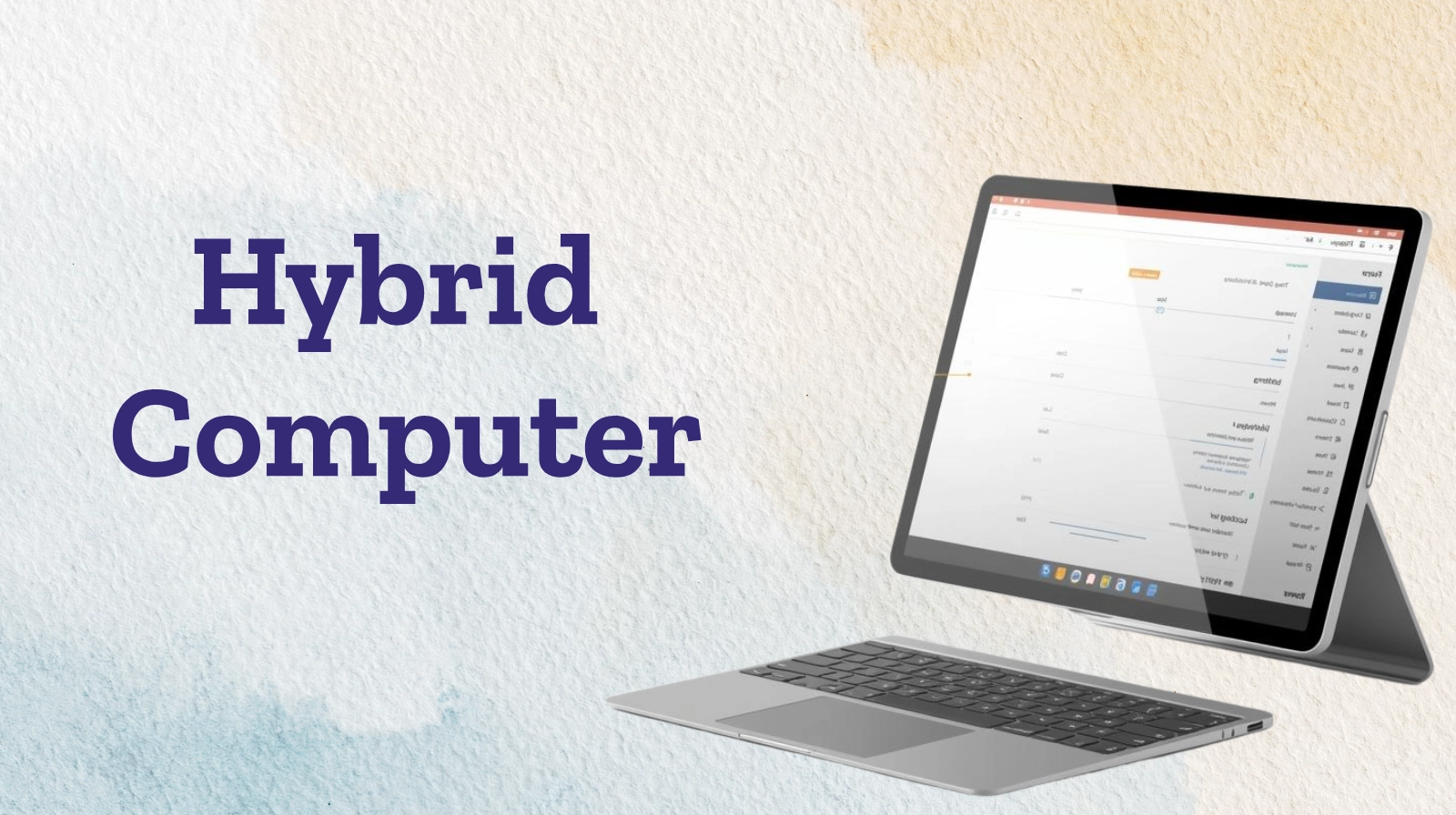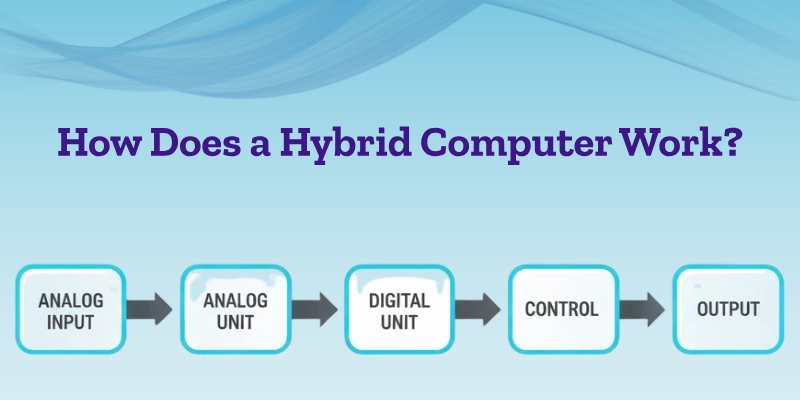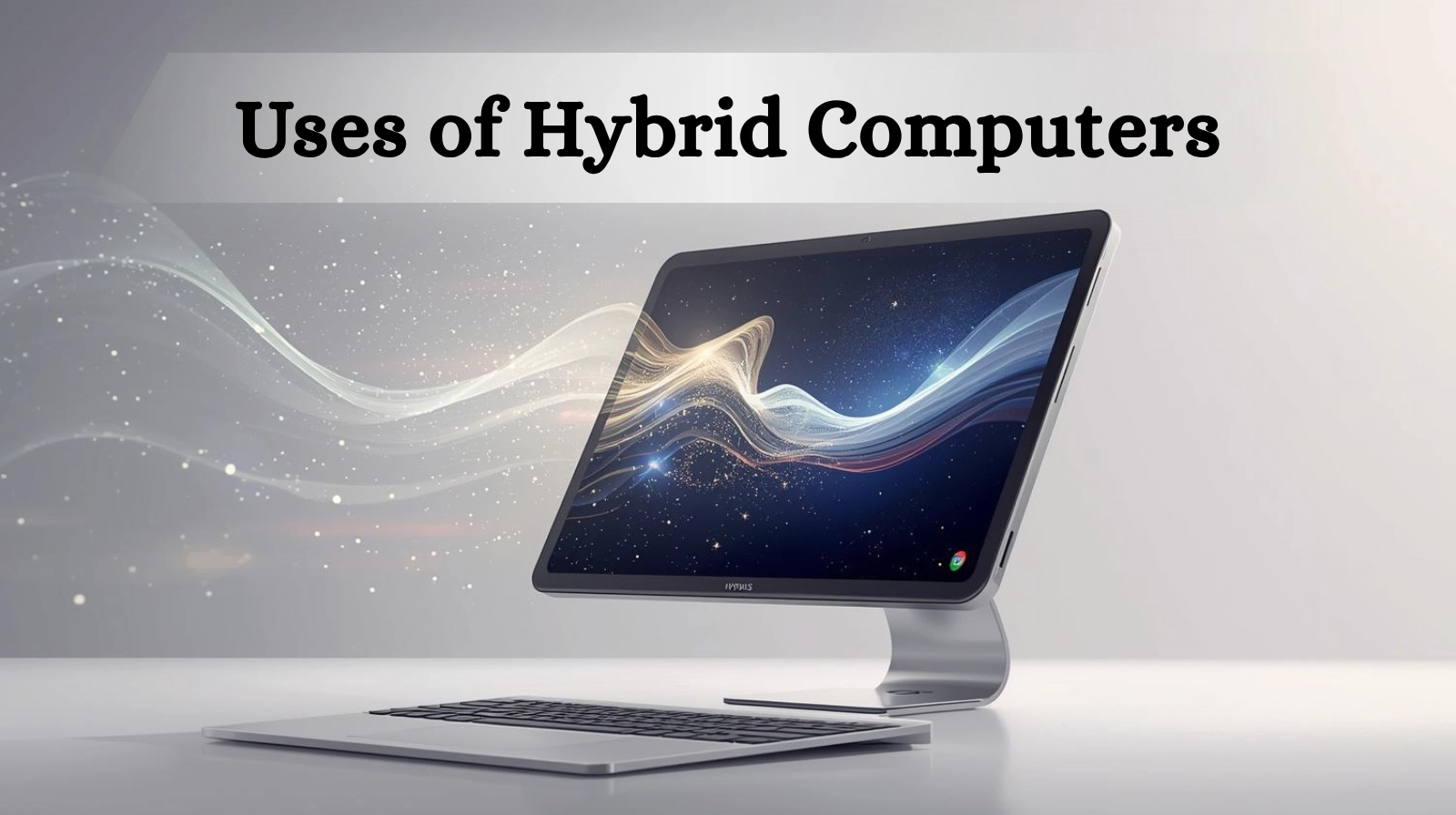Hybrid Computers: Discover the Power of Two Worlds
Published: 22 Oct 2025
A computer that combines the speed of digital computers with the accuracy of analog computers, that’s a hybrid computer! Unlike regular computers, hybrid computers merge the features of both analog and digital systems to solve complex and specialized tasks.
They are especially important in science labs, hospitals, and industries where precision and speed are both crucial.
In this article, you will learn everything about hybrid computers, from their definition and working to their parts, types, advantages, disadvantages, and real-life uses.
What is a Hybrid Computer?
A hybrid computer is a type of computer that combines analog and digital components to perform both continuous (analog) and discrete (digital) computations. This unique combination allows it to handle complex tasks that require speed and accuracy.

In simple words, a hybrid computer is a mix of analog and digital computers. It is faster and more accurate than ordinary computers for special tasks that need both types of calculations.
Examples:
Some real-life uses of hybrid computers include:
- Hospital patient monitoring systems: For tracking vital signs accurately.
- Flight simulators: For training pilots with realistic controls.
- Industrial control systems: For managing machines and processes efficiently.
Features of a Hybrid Computer
Hybrid computers have unique features that make them ideal for specialized tasks. Here are the main features of a hybrid computer:
- Combines analog and digital processing: It can perform both continuous and discrete calculations.
- Faster than analog computers: Digital components speed up complex computations.
- More accurate than digital computers in certain tasks: Analog components improve precision for specific measurements.
- Can handle real-time operations: Ideal for applications that require instant responses.
- Used for specialized applications: Commonly found in scientific simulations, hospital monitoring systems, and industrial controls.
These hybrid computer characteristics make them different from ordinary analog or digital computers, giving them a unique place in technology.
Parts of a Hybrid Computer
Hybrid computers have parts of both digital and analog computers that work together to perform specialized tasks. Here are the main parts of a hybrid computer:
- Analog Unit:
The analog unit handles continuous data like temperature, pressure, or speed. It converts physical quantities into electrical signals that the computer can process. - Digital Unit:
The digital unit handles discrete data such as numbers and characters. It performs fast calculations and stores data digitally for accurate results. - Input Devices:
Input devices receive analog or digital signals from users or sensors. Common examples include: Keyboard, Mouse, Sensors. - Output Devices:
Output devices display results in analog or digital form. Examples include: Monitor, Printer, Dial, Speaker. - Control Unit:
The control unit manages both analog and digital operations. It ensures that all processing steps happen in the correct sequence. - Storage Unit:
The storage unit stores digital data. It can also temporarily store analog signals in memory circuits for processing.
These components of a hybrid computer work together to make hybrid computers fast, accurate, and suitable for specialized applications.
How Does a Hybrid Computer Work?
Understanding how a hybrid computer works is easy if we look at its steps one by one. The working of a hybrid computer combines both analog and digital processing to deliver accurate and fast results.

This simple hybrid computer process allows the system to combine speed and accuracy, making it ideal for hospitals, scientific labs, and industrial applications.
- Input Stage: The computer receives both analog and digital data from sensors, users, or other devices.
- Analog Processing Unit: This unit handles continuous data like temperature, pressure, or speed and converts it into electrical signals.
- Digital Processing Unit: This unit processes discrete data such as numbers, logic, and instructions. It performs calculations and stores information digitally.
- Control Unit: The control unit manages and coordinates both analog and digital operations, ensuring the process runs smoothly.
- Output Stage: Finally, the results are delivered in analog or digital form through output devices like monitors, printers, or speakers.
Types of Hybrid Computers
Hybrid computers can be classified in different ways depending on their applications or technology. They combine the strengths of both analog and digital computers to perform specialized tasks.
Hybrid computers can be classified in different ways, depending on their applications or technology.
Based on Applications
Hybrid computers are used in specific fields like medicine, industry, and scientific research. Each application type focuses on solving real-world problems efficiently and accurately.
- Medical Hybrid Computers: Used in patient monitoring systems, ECG machines, and other healthcare applications.
- Industrial Hybrid Computers: Used for process control and automation in factories.
- Scientific Hybrid Computers: Used in research labs for simulations and scientific calculations.
Based on Technology
Hybrid computers can be analog-dominant or digital-dominant depending on which component is more prominent. This classification helps in choosing the right hybrid system for a particular task.
- Analog-Dominant Hybrid Computers: Primarily use analog processing with some digital support.
- Digital-Dominant Hybrid Computers: Primarily digital but include analog components for specific tasks.
| Feature | Analog Computer | Digital Computer | Hybrid Computer |
| Data Type | Continuous | Discrete | Both |
| Speed | Moderate | High | High |
| Accuracy | Moderate | High | High for critical tasks |
| Applications | Scientific | Office, Gaming | Hospitals, Research |
| Example | Slide Rule | PC, Laptop | Patient Monitoring Systems |
Advantages and Disadvantages of Hybrid Computers
The benefits and drawbacks of hybrid computers show how they combine the speed of digital systems with the accuracy of analog systems. Understanding these points helps in deciding where hybrid computers are most useful.
| Pros | Cons |
| Combines the speed of digital and the accuracy of analog systems | Expensive to build and maintain |
| Can handle real-time operations efficiently | Complex design and operation |
| Ideal for specialized tasks like medical monitoring and scientific simulations | Requires skilled personnel to operate |
| High accuracy for critical measurements | Limited general-purpose use |
| Can process both continuous and discrete data | Not as widely available as digital computers |
Uses of Hybrid Computer
Hybrid computers are widely used where both speed and accuracy are required. These applications of hybrid computers show how versatile they are in real-world scenarios.

Here are the main uses of hybrid computer in different fields:
- Medical Field: Used in ECG machines, EEG monitoring, and patient monitoring systems for accurate health tracking.
- Industrial Sector: Helps in process control, assembly line monitoring, and managing industrial operations efficiently.
- Scientific Research: Used for weather forecasting, scientific simulations, and research experiments.
- Defense and Aviation: Essential in flight simulators, missile guidance systems, and aviation control systems.
- Engineering: Supports design testing, automation, and control systems in various engineering projects.
Difference Between Hybrid, Analog, and Digital Computers
Hybrid computers combine the features of analog and digital computers, making them unique for specialized tasks. Understanding the difference between hybrid and digital computer or analog systems helps in choosing the right type for specific applications.
| Feature | Analog | Digital | Hybrid |
| Data Type | Continuous | Discrete | Both |
| Speed | Medium | High | High |
| Accuracy | Medium | High | High |
| Example | Slide Rule | PC | Patient Monitoring System |
| Application | Scientific | Office | Research, Medical |
This table clearly shows the hybrid vs analog vs digital computer differences, highlighting how hybrid computers combine the advantages of both types.
Conclusion
In this guide, we’ve learned about hybrid computers, their working, parts, types, and uses. A hybrid computer combines analog and digital systems to solve complex tasks efficiently.
They are fast, accurate, and perfect for specialized applications like hospitals, research labs, and industries.
Hybrid computers may not be in every home, but they quietly make hospitals, research labs, and industries smarter and faster every day.
FAQs
Got more questions about hybrid computers? Check out these FAQs to get clear and easy answers!
A hybrid system combines two or more types of technologies or components to work together. It uses the strengths of each system for better performance.
It combines analog and digital processing, handles real-time operations, is fast, accurate, and ideal for specialized tasks. These features make it useful in hospitals, industries, and research.
The main advantage is that it is both fast and accurate. It can handle complex tasks that normal computers cannot.
They are used in medical monitoring, industrial process control, scientific research, aviation, and engineering. Hybrid systems solve specialized and real-time problems.
Based on applications: medical, industrial, and scientific. Based on technology: analog-dominant, digital-dominant, and balanced hybrids.
Hybrids are used to combine speed and accuracy in processing data. They handle both continuous and discrete data for complex tasks.
It mixes analog and digital components, processes both continuous and discrete data, and can operate in real-time. It is fast, precise, and suitable for specialized applications.
The most common type is digital-dominant hybrid computers. They mainly use digital components with some analog support for accuracy.

- Be Respectful
- Stay Relevant
- Stay Positive
- True Feedback
- Encourage Discussion
- Avoid Spamming
- No Fake News
- Don't Copy-Paste
- No Personal Attacks

- Be Respectful
- Stay Relevant
- Stay Positive
- True Feedback
- Encourage Discussion
- Avoid Spamming
- No Fake News
- Don't Copy-Paste
- No Personal Attacks





